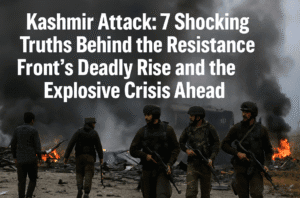Kashmir Attack: 7 Shocking Truths Behind the Resistance Front’s Deadly Rise and the Explosive Crisis Ahead
The April 22, 2025, attack in Pahalgam, where 26 Indian tourists were killed, marks the deadliest civilian massacre in Kashmir in decades, highlighting the volatile situation in the region. Claimed by the Resistance Front (TRF), a group that emerged post-2019 after India revoked Kashmir’s autonomy, the strike was timed with U.S. Vice President J.D. Vance’s India visit and domestic tensions over the Waqf Amendment Act. TRF, though projecting a secular nationalist image, is believed to be backed by Pakistan’s ISI and linked to Lashkar-e-Taiba.
The fallout has strained Indo-Pak ties, with India retaliating diplomatically and economically. The crisis has intensified scrutiny on India’s internal policies and raised global concern, especially as the U.S.-India-China power dynamic shifts. TRF’s rise is rooted in local discontent over identity and autonomy, exacerbated by militarization. As nuclear-armed neighbors posture for dominance, the need for dialogue and meaningful engagement is more urgent than ever. Kashmir’s future depends not just on security, but on justice and representation.

Kashmir Attack: 7 Shocking Truths Behind the Resistance Front’s Deadly Rise and the Explosive Crisis Ahead
The recent massacre of 26 tourists in India’s Pahalgam region has reignited tensions in Kashmir, a decades-old flashpoint between nuclear rivals India and Pakistan. The attack, claimed by the shadowy Resistance Front (TRF), underscores the fragile stability of a region where local grievances, geopolitical rivalries, and shifting global alliances collide. Here’s what you need to understand about the group, its motives, and the risks of escalation.
The Attack and Its Timing
On April 22, 2025, gunmen targeted a resort in Pahalgam, a scenic valley popular with Indian tourists. Most victims were Indian nationals, marking the deadliest assault on civilians in Kashmir in 25 years. The attack coincided with two critical events:
- U.S. Vice President J.D. Vance’s visit to India, aimed at strengthening U.S.-India ties amid rising tensions with China.
- India’s controversial Waqf Amendment Act, which critics argue undermines Muslim autonomy over religious properties.
This timing suggests strategic intent. By striking during a high-profile diplomatic visit and amid domestic policy turmoil, the perpetrators amplified their message: Kashmir remains a powder keg.
Who Is the Resistance Front (TRF)?
Emerging in 2019 after India revoked Kashmir’s semi-autonomous status, the TRF positions itself as a nationalist movement fighting for Kashmiri independence. Unlike older militant groups with overtly Islamist names (e.g., Lashkar-e-Taiba), the TRF’s branding emphasizes secular resistance, appealing to broader anti-Indian sentiment.
Key Facts About TRF:
- Origins: Formed in response to India’s 2019 decision to split Jammu and Kashmir into federally controlled territories, enabling non-locals to own land and access jobs—a move seen as eroding Kashmiri identity.
- Tactics: Relies on social media for recruitment and propaganda, mirroring modern insurgent playbooks.
- Links: Allegedly tied to Pakistan’s Inter-Services Intelligence (ISI) and Lashkar-e-Taiba (LeT), though Pakistan denies involvement.
In 2023, India designated TRF as a terrorist group, accusing it of targeting civilians, security forces, and politicians.
Why Pakistan’s Role Matters
India has long accused Pakistan of funding and training Kashmir-focused militants. While Islamabad denies ties to TRF, analysts note parallels between TRF’s operations and LeT’s tactics. The recent extradition of Tahawwur Rana—a key suspect in the 2008 Mumbai attacks—to India has further strained relations.
Escalation Risks:
- India retaliated by closing a key border crossing, expelling Pakistani diplomats, and suspending the Indus Waters Treaty, which governs shared river resources.
- With both nations armed with nuclear weapons, even a minor skirmish could spiral into conflict.
Broader Implications
- Domestic Politics: India’s Hindu-nationalist government faces scrutiny over policies like the Waqf Act, perceived as marginalizing Muslims. The attack may harden Modi’s stance on security and minority rights.
- Global Alliances: The U.S. seeks closer ties with India to counter China, but Pakistan’s historical alliance with Beijing adds complexity.
- Kashmir’s Future: TRF’s rise reflects local anger over demographic shifts and lost autonomy. Military crackdowns risk fueling further radicalization.
A Path Forward?
De-escalation hinges on addressing root causes:
- Dialogue: Reviving India-Pakistan talks on Kashmir, stalled since 2019.
- Local Engagement: Addressing Kashmiri grievances around identity, resources, and political representation.
- International Pressure: Global powers like the U.S. and China must discourage proxy warfare.
For now, Kashmir remains a tinderbox. The Pahalgam attack is not just a tragedy—it’s a stark reminder that unresolved conflicts in South Asia threaten more than regional stability.
You must be logged in to post a comment.